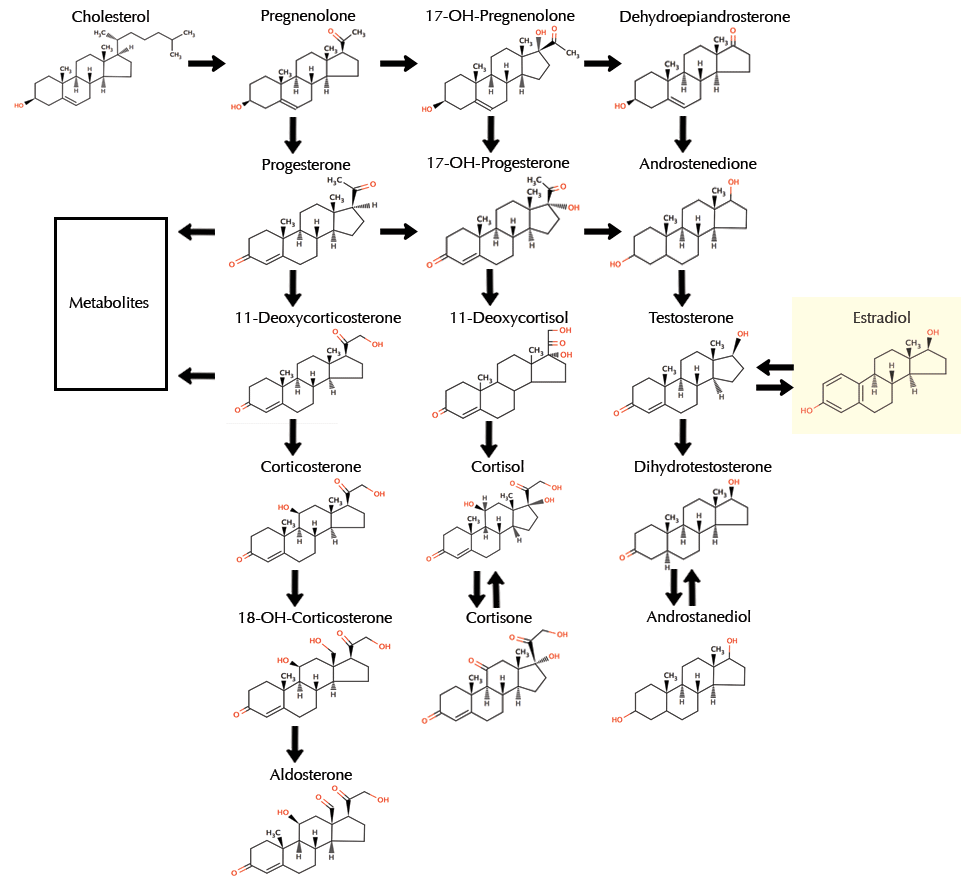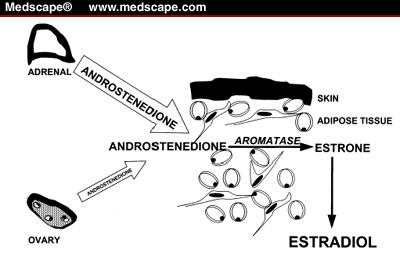What are estrogens?
Estrogen is often thought of as the “female sex hormone”, but in fact it’s prevalent in both men and women.
There are actually a few forms of estrogen — the term usually refers to a family of steroid hormones that are synthesized in a variety of tissues.
- Estradiol (sometimes known as E2) is the most potent estrogen. In women it’s produced by the ovaries.
- Estriol (sometimes known as E3) is produced during pregnancy. Non-pregnant women don’t make much of it at all.
- Estrone (sometimes known as E1) is the most dominant estrogen in menopausal women.
Most often when people talk about “estrogen” they really mean estradiol. Estrone and estriol have about one tenth the potency of estradiol.
How our bodies make estrogens
Estrogens, like other sex hormones, are derived from cholesterol. They’re created by the aromatization (conversion) of androgens in an intricate process.
It’s easy to assume that so-called “male hormones” and “female hormones” are “opposites”. In fact, as the diagram below shows, the early stages of synthesizing estradiol and testosterone (and other androgens) are exactly the same!
Estradiol is formed if the substrate is testosterone, whereas estrone results from the aromatization of androstenedione.
In pre-menopausal women, the most important producer of estrogens are the ovaries. In post-menopausal women (whose ovaries have gradually ceased production), adipose (aka fat) tissue also plays a role. In men, the main source of estrogen is testosterone that has aromatized.
Because fat tissue can produce hormones, excess body fat can disrupt proper hormonal balance.
Regulating estrogen
So what signals estrogen release? Well, the hypothalamus secretes a hormone known as gonadotropin-releasing hormone (GnRH). GnRH regulates luteinizing hormone (LH) and follicle stimulating hormone (FSH) release from the pituitary gland. LH and FSH stimulate secretion of estrogen from the ovaries.
Estrogen is released in pulses at intervals of 1 to 3 hours.

Hormones can circulate in the body in both “bound” and “unbound” forms. Bound hormones are attached to something else, e.g. a transport protein such as sex hormone binding globulin (SHBG). (Imagine a bunch of kids hitching a ride on an inner tube as it’s pulled down a lazy river ride and you’ll get the idea.) Unbound hormones circulate freely.
Once released, only unbound estrogen appears to be biologically active.
Why are estrogens so important?
Estrogens are essential regulators of many major processes in the body. For example:
- They strongly influence the deposit of body fat — both amount and location.
- They also influence muscle mass.
- Estradiol has cardioprotective properties via changes in vasculature and other tissues. This is why premenopausal women have much lower rates of cardiovascular diseases than men — but their risk sharply increases after menopause.
- Estrogen acts on bone to determine the overall balance of breakdown and formation. Estrogen inhibits bone breakdown and may stimulate bone formation by initiating synthesis of IGF-1. After estradiol withdrawal during menopause (and with exercise induced amenorrhea in young female athletes) the pace of bone breakdown becomes limited, and mechanical loading is effective only in bones that are exposed to stress.
The menstrual cycle
Estradiol levels (red line in diagram below) normally fluctuate during a woman’s menstrual cycle, peaking just before ovulation and falling around the time of menstruation.
Researchers have explored whether these cyclical changes have effects on exercise performance, wellbeing, and body composition.
Stress hormones
The menstrual cycle has little effect on the secretion of stress hormones such as growth hormone during exercise. When exercise takes place at times when estradiol levels are higher, cortisol secretion is either unaffected or suppressed. Aldosterone secretion is higher at these times and may contribute to increased fluid retention.
Fuel use
Estrogen variations during the menstrual cycle have a minimal effect on fuel utilization. Lipid utilization may be higher during the luteal phase following ovulation.
High estradiol is associated with decreased fat storage enzyme activity. High estradiol also contributes to higher HDL levels (aka the “good cholesterol”, which is cardioprotective).
Estradiol increases free fatty acid and triglyceride content of muscle and fat tissue, inhibits fat storing enzymes, and increases fat mobilizing enzymes during exercise.
Thermoregulation
Core temperature is lowest during ovulation and highest during the luteal phase of the cycle. During the luteal phase of the menstrual cycle, thresholds for vessel dilation and sweating increase.
Appetite, hunger and satiety hormones
CCK (cholescystokinin) mediates estradiol-induced suppression of appetite during menstrual cycles.
Male and female reproductive hormones exert a differential effect on leptin expression, which results in greater circulating leptin levels in women (higher leptin is associated with appetite suppression).
Body fat
An increase of the masculinizing hormones along with a decrease of estrogen in women is associated with higher levels of intra-abdominal body fat (often known as the “apple shape”). You may also know that insulin resistance is associated with accumulation of intra-abdominal body fat.
What you should know
Normal serum levels:
| Estradiol | Estrone | |
| Male | Less than 50 pg/mL | 29-81 pg/mL |
| Female | Follicular phase 10-200 pg/mL Midcycle 100-400 pg/mL Luteal phase 15-260 pg/mL Postmenopausal less than 50 pg/mL |
Follicular phase 37-152 pg/mL Midcycle 72-200 pg/mL Luteal phase 49-114 pg/mL Postmenopausal about 65 pg/mL (without estrogen replacement) |
Men, women, and estrogens
Considerable amounts of estrogens are formed by the aromatization of androgens.
In males, the aromatization of testosterone to estradiol accounts for 80% of what is produced. In females, nearly 50% of the estradiol created during pregnancy comes from the aromatization of androgens. The conversion of androstendione to estrone is the foremost source of estrogens in post-menopausal women.
Aromatase is an enzyme that’s required to convert androgens to estrogens. It’s active in adipose cells, liver cells, skin cells, and other tissues. With excess body fat, production of estrogen (and other hormones and cell signalers) increases. This is why many health conditions such as gynecomastia (male breast growth), reproductive disorders, and breast cancer are linked to obesity — as well as why aromatase inhibitors are often prescribed for these conditions.
Exercise of moderate to high intensity is associated with increases of sex hormones in a gender specific fashion. Males display little change of estradiol and estrone in response to exercise.
In women, increases of estrogen are proportional to exercise intensity and more prominent during the luteal phase than during the follicular phase of the menstrual cycle. Increases in plasma progesterone occur during the luteal phase of the cycle only.
For extra credit
Estradiol levels decline rapidly during the first week after birth and remain at about 8 to 10 pg/mL in females and males until onset of puberty.
Estrogens are bound to SHBG. SHBG binds estradiol about five times less avidly than it binds testosterone.
During pregnancy, at moderate intensity exercise, estradiol secretion is increased, more so in the later stages of pregnancy.
17% fat is the threshold of body fat necessary for the onset of menarche, and 22% fat is the threshold level of body fat necessary for the maintenance of fertile menstrual cycles. This relationship proposes that female fertility is dependent on the availability of 99,000 calories contained in 11 kg of body fat, enough to provide the 80,000 calories needed for a full-term pregnancy.
Acute reduction in energy availability to less than 25 kcal/kg of lean body mass (via exercise), precipitates reductions in LH pulses. Reduction of LH pulsatility is more severe after dietary restriction than after increased energy expenditure from exercise. Changes in LH pulsatility in exercising women are prevented when increased food intake adequately compensates for the energy cost of exercise. · At least four different mechanisms may contribute to development of exercise-induced amenorrhea.
- Effects of acute energy drain
- Level of body fat stores
- Increased levels of inappropriate sex steroids
- Increased levels of stress hormones
At submaximal exercise intensities, women release and oxidize more fat tissue and rely less on muscle lipids and glycogen than do men.
Males need estrogen during fetal development — it actually masculinizes the brain.
There are also other forms of estrogen-like compounds, such as those found in plants like soy (aka phytoestrogens), or xenoestrogens with estrogen-like actions that occur in things like plastics or pesticides. There are even mycoestrogens, made by fungi!
Summary and recommendations
To maintain healthy estrogen levels:
- Eat enough quality calories
- Avoid bouts of overtraining
- Be aware of exercise intensity throughout pregnancy
- Maintain a healthy body fat level
- Avoid use of exogenous androgens
- No fad dieting
References
Click here to view the information sources referenced in this article.
Learn more
Want to get in the best shape of your life, and stay that way for good? Check out the following 5-day body transformation courses.
The best part? They're totally free.
To check out the free courses, just click one of the links below.








Share